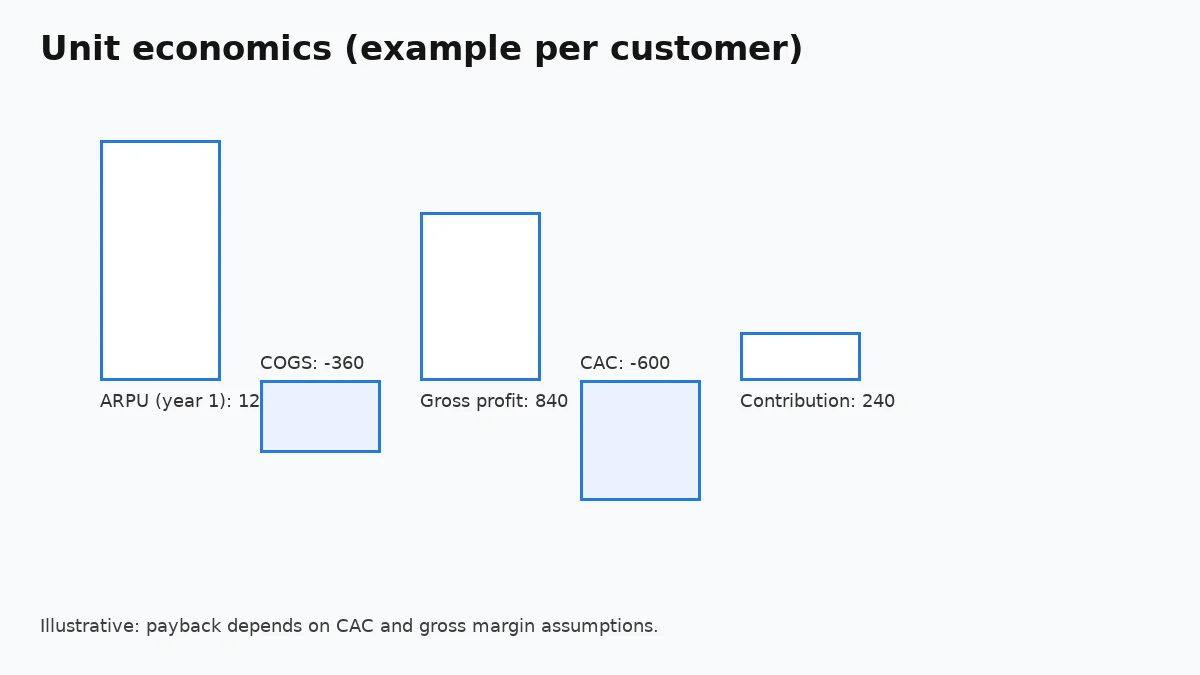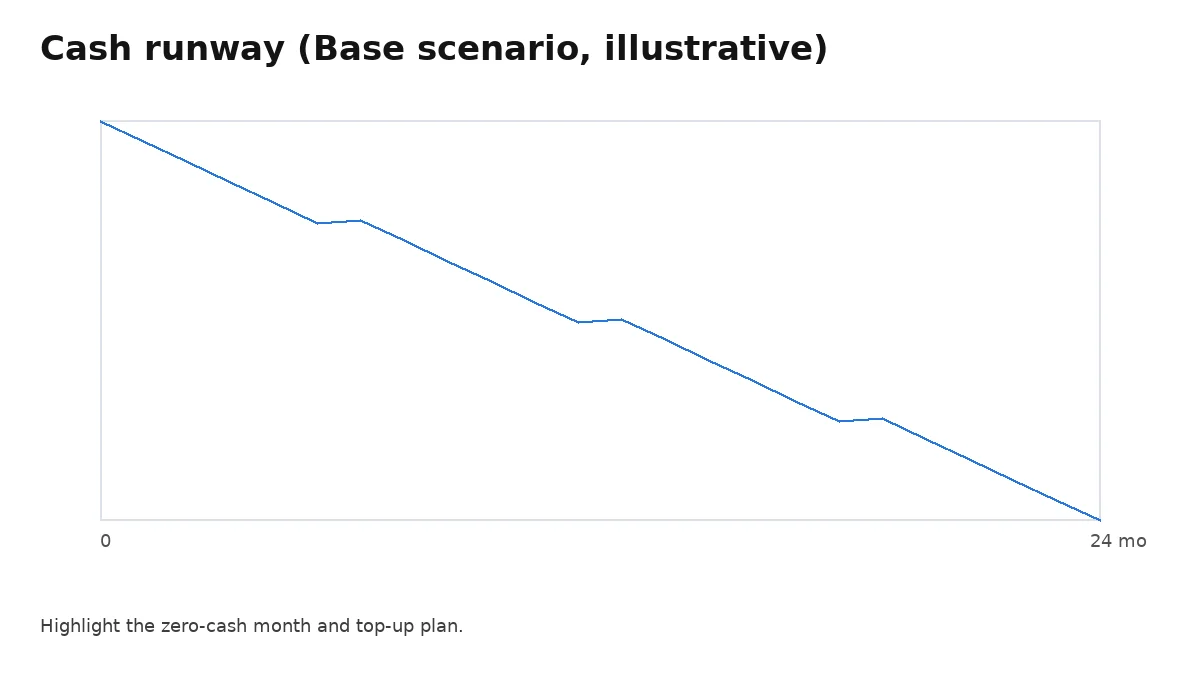A pragmatic Seed–A financial model: revenue build, hiring plan, unit economics, runway scenarios, and hygiene—plus visuals and CSVs.
Your financial model should help you decide, not impress. This Seed–A template covers the must‑haves: a bottom‑up revenue build, a hiring‑driven cost plan, clear unit economics, and simple scenarios for runway. It’s pragmatic, fast to update, and easy to share with investors.
Key takeaways: Model monthly for 24–36 months. Build revenue bottom‑up from drivers, tie costs to the hiring plan, and keep a small KPI set (ARR, NRR, Gross Margin, Burn/Runway, CAC payback). Version with dates and lock a PDF for sharing.
Six tabs, bottom‑up revenue, hiring‑driven costs, and clear runway.
Use 6 tabs: Assumptions, Revenue, Costs & Hiring, Unit Economics, Cash & Runway, KPI Dashboard. Keep inputs blue, formulas black, and outputs green.
Start from today’s baseline, add changes only where you have a story, and create three scenarios: Base, Upside, and Conservative. Investors care that assumptions are consistent and traceable—not that the sheet has 20 tabs.

One assumptions page feeds Revenue and Costs; Unit Economics and Cash read from those; the KPI Dashboard charts the result.
Assumptions: prices, conversion, churn, sales productivity. Revenue: cohorts or funnel math. Costs & Hiring: headcount by function with salary, start date, benefits, and vendor costs. Unit Economics: LTV, CAC, payback, gross margin. Cash & Runway: bank, burn, months of runway.
Derive new business from funnel inputs (visits → trials → paid) or sales productivity (AEs × quota × attainment), then layer churn and expansion.
Prefer cohort math over averages. Keep price, discount, and ramp assumptions visible. For marketplaces/fintech, model GMV/TPV drivers and take rate.
Headcount drives most costs—model hires one by one with start dates and fully loaded costs. Vendor costs sit in a short GL list.
Avoid lump sums. Tie software and infra costs to usage where possible. Add a simple capex and depreciation row if relevant.

Show LTV/CAC, CAC payback, and gross margin. These should stabilise as the model scales; large swings mean an assumption is off.
For subscriptions, compute LTV from gross margin and churn; for transactional models, use contribution margin per order and repeat rate.

Chart bank balance by month; highlight the zero‑cash month. Keep Base, Upside (+10–20% top‑line, slower churn), and Conservative (−20% top‑line, slower hiring).
Use data validation to switch scenarios. If Base runway < 18 months, decide: reduce burn, raise earlier, or change the plan.
A single page: ARR, Net New ARR, Gross Margin, Burn & Runway, CAC Payback, NRR/Logo Retention. Same charts every month.
Link each chart to its source range. Add notes for one‑offs and policy changes (e.g., price rise).
Protect formulas, name ranges, and keep a change log. Save a PDF with the KPI page and key tables for circulation.
Use ISO naming (YYYY‑MM) and avoid ‘final_v7’. Store in your corporate folder with permissions. Keep a read‑only copy for diligence.
If you host live KPI charts, keep INP ≤200 ms, LCP ≤2.5 s, CLS ≤0.1. Prefer static images and reserved dimensions.
Compress WebP, preconnect to your CDN, and delay non‑critical scripts. Avoid layout shifts by setting width/height on images.
Related reads: Diligence Prep Checklist, Board Meeting Playbook, Monthly Investor Update Template.
Anchor inputs with sensible ranges so scenarios stay realistic.
Move one assumption at a time, then combine the top two.
Simple cohort ladder keeps retention honest.
Send the story, not the raw workbook.
Keep the model a decision tool.
ARR: annualised recurring revenue. NNR: Net New Revenue/ARR. LTV: lifetime value (gross margin adjusted). CAC: customer acquisition cost. Payback: months to recover CAC on gross margin basis.
Update monthly; audit quarterly.
Paste actuals, annotate changes, and reset Base/Conservative/Up to reflect reality. Revisit the KPI set twice a year and drop vanity metrics.
Model price tests explicitly so the team can learn.
Explain how cash moves, not just the end balance.
Granularity here prevents budget surprises.
Future you will thank present you.
Name with ISO dates (2025-08 SeedA-Model-v1.3.xlsx), keep a “Changes” tab (date, author, summary), and export a PDF of KPI & key tables each month into your corporate folder. For diligence, include the assumptions page and cohort tables.
Attach each KPI to a source and owner.
Next to every chart add a small note: formula, BI query/report, and the person accountable for quality. For example, “ARR = Σ active subs × annual price; Source: BI query 42; Owner: Finance; Cadence: monthly; Last refreshed: 2025‑08‑01.” This kills definitional debates and turns your model into a reliable operating system.
Quick answers on Seed–A models.
Want a clean Seed–A model investors can trust?


© EA Partners 2025. All Rights Reserved.